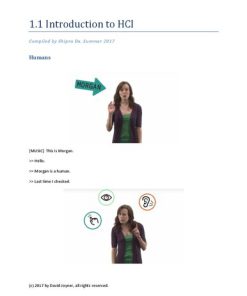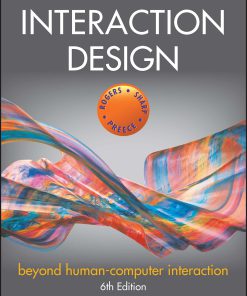Designing the User Interface 6th Edition by Ben Shneiderman, Catherine Plaisant, Maxine Cohen, Steven Jacobs, Niklas Elmqvist, Nicholas Diakopoulos ISBN 9780134380384 013438038X
$50.00 Original price was: $50.00.$25.00Current price is: $25.00.
Designing the User Interface 6th Edition by Ben Shneiderman, Catherine Plaisant, Maxine Cohen, Steven Jacobs, Niklas Elmqvist, Nicholas Diakopoulos – Ebook PDF Instant Download/Delivery: 9780134380384 ,013438038X
Full download Designing the User Interface 6th Edition after payment

Product details:
ISBN 10: 013438038X
ISBN 13: 9780134380384
Author: Ben Shneiderman, Catherine Plaisant, Maxine Cohen, Steven Jacobs, Niklas Elmqvist, Nicholas Diakopoulos
Designing the User Interface 6th Edition Table of contents:
Part 1 Introduction
Chapter 1 Usability of Interactive Systems
Chapter Outline
1.1 Introduction
1.2 Usability Goals and Measures
1.3 Usability Motivations
1.3.1 Consumer electronics, e-commerce, and social media
1.3.2 Games and entertainment
1.3.3 Professional environments
1.3.4 Exploratory, creative, and collaborative interfaces
1.3.5 Sociotechnical systems
1.4 Goals for Our Profession
1.4.1 Influencing academic and business researchers
1.4.2 Providing tools, techniques, and knowledge for commercial designers
1.4.3 Raising the user-interface consciousness of the general public
Practitioner’s Summary
References
Chapter 2 Universal Usability
Chapter Outline
2.1 Introduction
2.2 Variations in Physical Abilities and Physical Workplaces
2.3 Diverse Cognitive and Perceptual Abilities
2.4 Personality Differences
2.5 Cultural and International Diversity
2.6 Users with Disabilities
2.7 Older Adult Users
2.8 Children
2.9 Accommodating Hardware and Software Diversity
Practitioner’s Summary
References
Chapter 3 Guidelines, Principles, and Theories
Chapter Outline
3.1 Introduction
3.2 Guidelines
3.2.1 Navigating the interface
3.2.2 Organizing the display
3.2.3 Getting the user’s attention
3.2.4 Facilitating data entry
3.3 Principles
3.3.1 Determine users’ skill levels
3.3.2 Identify the tasks
3.3.3 Choose an interaction style
Direct manipulation
Navigation and menu selection
Form fill-in
Command language
Natural language
3.3.4 The Eight Golden Rules of Interface Design
3.3.5 Prevent errors
3.3.6 Ensuring human control while increasing automation
3.4 Theories
3.4.1 Design-by-levels theories
3.4.2 Stages-of-action theories
3.4.3 Consistency theories
3.4.4 Contextual theories
3.4.4 Dynamic theories
Practitioner’s Summary
References
Part 2 Design Processes
Chapter 4 Design
Chapter Outline
4.1 Introduction
4.2 Organizational Support for Design
4.3 The Design Process
4.3.1 Phase 1: Requirements analysis
4.3.2 Phase 2: Preliminary and detailed design
4.3.3 Phase 3: Build and implementation
4.3.4 Phase 4: Evaluation
4.4 Design Frameworks
4.4.1 User-centered design
4.4.2 Participatory design
4.4.3 Agile interaction design
4.5 Design Methods
4.5.1 Ideation and creativity
4.5.2 Surveys, interviews, and focus groups
4.5.3 Ethnographic observation
4.5.4 Scenario development and storyboarding
4.5.5 Prototyping
4.6 Design Tools, Practices, and Patterns
4.6.1 Design tools
4.6.2 Design guidelines and standards
4.6.3 Interaction design patterns
4.7 Social Impact Analysis
4.8 Legal Issues
Practitioner’s Summary
References
Chapter 5 Evaluation and the User Experience
Chapter Outline
5.1 Introduction
5.2 Expert Reviews and Heuristics
5.3 Usability Testing and Laboratories
5.3.1 Usability labs
5.3.2 Ethics in research practices with human participants
5.3.3 Think-aloud and related techniques
5.3.4 The spectrum of usability testing
5.3.5 Usability test reports
5.4 Survey Instruments
5.4.1 Preparing and designing survey questions
5.4.2 Sample questionnaires
5.5 Acceptance Tests
5.6 Evaluation during Active Use and Beyond
5.6.1 Interviews and focus-group discussions
5.6.2 Continuous user-performance data logging
5.6.3 Online or chat consultants, e-mail, and online suggestion boxes
5.6.4 Discussion groups, wikis, newsgroups, and search
5.6.5 Tools for automated evaluation
5.7 Controlled Psychologically Oriented Experiments
5.7.1 Experimental approaches
5.7.2 Experimental design
Practitioner’s Summary
References
Chapter 6 Design Case Studies
Chapter Outline
6.1 Introduction
6.2 Case Study 1: Iterative Design Evaluation of Automated Teller Machines (ATMs)
Observations
6.3 Case Study 2: Design Consistency at Apple Computer
Observations
6.4 Case Study 3: Data-Driven Design at Volvo
Observations
6.5 General Observations and Summary
Practitioner’s Summary
References
Part 3 Interaction Styles
Chapter 7 Direct Manipulation and Immersive Environments
Chapter Outline
7.1 Introduction
7.2 What Is Direct Manipulation?
7.2.1 The three principles and attributes of direct manipulation
7.2.2 Translational distances with direct manipulation
7.2.3 Problems with direct manipulation
7.2.4 The continuing evolution of direct manipulation
7.3 Some Examples of Direct Manipulation
7.3.1 Geographical systems including GPS (global positioning systems)
7.3.2 Video games
7.3.3 Computer-aided design and fabrication
7.3.4 Direct-manipulation programming and configuration
7.4 2-D and 3-D Interfaces
7.5 Teleoperation and Presence
7.6 Augmented and Virtual Reality
7.6.1 Augmented reality
7.6.2 Virtual reality
Practitioner’s Summary
References
Chapter 8 Fluid Navigation
Chapter Outline
8.1 Introduction
8.2 Navigation by Selection
8.2.1 Menu bars, pop-up menus, toolbars, palettes, and ribbons
8.2.2 Shortcuts and gestures for rapid interaction
8.2.3 Long lists
Scrolling menus, combo boxes, and fisheye menus
Sliders and alphasliders
Two-dimensional mega menus
8.2.4 Linear versus simultaneous presentation
8.3 Small Displays
8.4 Content Organization
8.4.1 Structure and breath versus depth
8.4.2 Sequence, phrasing, and layout
Sequence
Phrasing
Layout
8.5 Audio Menus
8.6 Form Fill-in and Dialog Boxes
8.6.1 Form fill-in
8.6.2 Format-specific fields
8.6.3 Dialog boxes
Practitioner’s Summary
References
Chapter 9 Expressive Human and Command Languages
Chapter Outline
9.1 Introduction
9.2 Speech Recognition
9.2.1 The place for spoken interaction
9.2.2 Speech recognition applications
9.2.3 Designing spoken interaction
Initiation
Knowing what to say
Recognition errors
Correcting errors
Mapping to possible actions
Feedback and dialogues
9.2.4 Spoken prompts and commands
9.3 Speech Production
9.4 Human Language Technology
9.5 Traditional Command Languages
Practitioner’s Summary
References
Chapter 10 Devices
Chapter Outline
10.1 Introduction
10.2 Keyboards and Keypads
10.2.1 Keyboard layouts
10.2.2 Accessible text entry
10.2.3 Keys
10.2.4 Mobile text entry
10.3 Pointing Devices
10.3.1 Pointing tasks and control modes
10.3.2 Direct-control pointing devices
10.3.3 Indirect-control pointing devices
10.3.4 Comparison of pointing devices
10.3.5 Fitts’s Law
10.3.6 Novel pointing devices
10.4 Displays
10.4.1 Display technology
10.4.2 Large wall displays
10.4.3 Tabletop (horizontal) displays
10.4.4 Heads-up and head-mounted displays
10.4.5 Mobile device displays
10.4.6 Deformable and shape-changing displays
Practitioner’s Summary
References
Chapter 11 Communication and Collaboration
Chapter Outline
11.1 Introduction
11.2 Models of Collaboration
11.2.1 Synchronicity
11.2.2 Physical distribution
11.2.3 Scale
11.2.4 Number of communities of practice
11.2.5 Nascence
11.2.6 Planned permanence
11.2.7 Turnover
11.3 Specific Goals and Contexts
11.3.1 Communication and conversation
11.3.2 Online markets
11.3.3 Meeting coordination
11.3.4 Creative production
11.3.5 Crowdsourcing and crowdwork
11.3.6 Entertainment and gaming
11.3.7 Education
11.4 Design Considerations
11.4.1 Cognitive factors
Common ground
Social cues
Activity awareness
Interruptions
11.4.2 Individual factors
Privacy
Identity
Trust and reputation
Motivation
Leadership
11.4.3 Collective factors
Deviance
Moderation
Policies and norms
Practitioner’s Summary
References
Part 4 Design Issues
Chapter 12 Advancing the User Experience
Chapter Outline
12.1 Introduction
12.2 Display Design
12.2.1 Field layout
12.2.2 Empirical results
12.2.3 Sequence of displays
12.3 View (Window) Management
12.3.1 Coordinating multiple views (windows)
12.3.2 Browsing large views
12.4 Animation
12.5 Webpage Design
12.6 Color
12.7 Nonanthropomorphic Design
12.8 Error Messages
12.8.1 Specificity
12.8.2 Constructive guidance and positive tone
12.8.3 Appropriate physical format
Practitioner’s Summary
References
Chapter 13 The Timely User Experience
Chapter Outline
13.1 Introduction
13.2 Models of System Response Time (SRT) Impacts
13.2.1 Website SRT
13.2.2 Network impacts to SRT
13.2.3 Factors for SRT modeling
13.3 Expectations and Attitudes
13.4 User Productivity and Variability in SRT
13.5 Frustrating Experiences
Practitioner’s Summary
References
Chapter 14 Documentation and User Support (a.k.a. Help)
Chapter Outline
14.1 Introduction
14.2 Shaping the Content of the Documentation
14.2.1 Organization and writing style
14.2.2 Writing for the web
14.3 Accessing the Documentation
14.3.1 Online documentation
14.3.2 Online help
Interactive help
System-initiated help
14.4 Reading from Displays versus Reading from Paper
14.4.1 Extended reading on displays
14.5 Online Tutorials and Animated Demonstrations
14.5.1 Online tutorials
14.5.2 Animated demonstrations and multimedia
14.6 Online Communities and Other Avenues for User Support
14.7 The Development Process
Practitioner’s Summary
References
Chapter 15 Information Search
Chapter Outline
15.1 Introduction
15.2 Five-Stage Search Framework
15.2.1 Formulation
15.2.2 Initiation of action
15.2.3 Review of results
15.2.4 Refinement
15.2.5 Use
15.3 Dynamic Queries and Faceted Search
15.4 Command Languages and “Natural” Language Queries
15.5 Multimedia Document Search and Other Specialized Search
15.5.1 Image search
15.5.2 Video search
15.5.3 Audio search
15.5.4 Geographic information search
15.5.5 Multilingual searches
15.5.6 Other specialized searches
15.6 The Social Aspects of Search
Practitioner’s Summary
References
Chapter 16 Data Visualization
Chapter Outline
16.1 Introduction
16.2 Tasks in Data Visualization
16.2.1 Data and view specification
16.2.2 View manipulation
16.2.3 Process and provenance
16.3 Visualization by Data Type
16.4 Challenges for Data Visualization
Practitioner’s Summary
References
Afterword Societal and Individual Impact of User Interfaces
Afterword Outline
A.1 Future Interfaces and Grand Challenges
A.2 Ten Plagues of the Information Age
Practitioner’s Summary
Name Index
People also search for Designing the User Interface 6th Edition:
designing interfaces o’reilly pdf
user interface design methods
interface design principles
interface design quick check
designing a user interface
Tags: Ben Shneiderman, Catherine Plaisant, Maxine Cohen, Steven Jacobs, Niklas Elmqvist, Nicholas Diakopoulos, User Interface
You may also like…
Computers - Computer Science
Uncategorized
Education Studies & Teaching - Education - General & Miscellaneous
Computers - Programming
Computers - Information Systems
Computers - Computer Science
Artificial Intelligence for Human Computer Interaction A Modern Approach First Edition Yang Li











